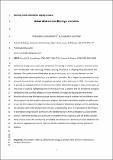Files in this item
Avian distraction displays : a review
Item metadata
| dc.contributor.author | Humphreys, Rosalind K. | |
| dc.contributor.author | Ruxton, Graeme D. | |
| dc.date.accessioned | 2021-02-08T00:38:37Z | |
| dc.date.available | 2021-02-08T00:38:37Z | |
| dc.date.issued | 2020-09-28 | |
| dc.identifier | 266484233 | |
| dc.identifier | ada93726-ebc3-4ad6-8de7-83180d79451e | |
| dc.identifier | 85079153803 | |
| dc.identifier | 000511625200001 | |
| dc.identifier.citation | Humphreys , R K & Ruxton , G D 2020 , ' Avian distraction displays : a review ' , Ibis , vol. 162 , no. 4 , pp. 1125-1145 . https://doi.org/10.1111/ibi.12814 | en |
| dc.identifier.issn | 0019-1019 | |
| dc.identifier.other | RIS: urn:5CA2F042666B1C766B8B85CC4E369D5D | |
| dc.identifier.uri | https://hdl.handle.net/10023/21386 | |
| dc.description | Funding: University of St Andrews and Perry Foundation. | en |
| dc.description.abstract | Distraction displays are conspicuous behaviours functioning to distract a predator's attention away from the displayer's nest or young, thereby reducing the chance of offspring being discovered and predated. Distraction is one of the riskier parental care tactics, as its success derives from the displaying parent becoming the focus of a predator's attention. Such displays are prominent in birds, primarily shorebirds, but the last comprehensive review of distraction was in 1984. Our review aims to provide an updated synthesis of what is known about distraction displays in birds, and to open up new areas of study by highlighting some of the key avenues to explore and the broadened ecological perspectives that could be adopted in future research. We begin by drawing attention to the flexibility of form that distraction displays can take and providing an overview of the different avian taxa known to use anti‐predator distraction displays, also examining species‐specific sex differences in use. We then explore the adaptive value and evolution of distraction displays, before considering the variation seen in the timing of their use over a reproductive cycle. An evaluation of the efficacy of distraction compared with alternative anti‐predator tactics is then conducted via a cost–benefit analysis. Distraction displays are also found in a handful of non‐avian taxa, and we briefly consider these unusual cases. We conclude by postulating why distraction is primarily an avian behaviour and set out our suggestions for future research into the evolution and ecology of avian distraction displays. | |
| dc.format.extent | 688269 | |
| dc.language.iso | eng | |
| dc.relation.ispartof | Ibis | en |
| dc.subject | Anti-predator defence | en |
| dc.subject | Behavioural ecology | en |
| dc.subject | Evolution | en |
| dc.subject | Nest defence | en |
| dc.subject | Parental care | en |
| dc.subject | Predator distraction | en |
| dc.subject | QH301 Biology | en |
| dc.subject.lcc | QH301 | en |
| dc.title | Avian distraction displays : a review | en |
| dc.type | Journal item | en |
| dc.contributor.institution | University of St Andrews. School of Biology | en |
| dc.contributor.institution | University of St Andrews. Centre for Biological Diversity | en |
| dc.identifier.doi | https://doi.org/10.1111/ibi.12814 | |
| dc.description.status | Peer reviewed | en |
| dc.date.embargoedUntil | 2021-02-08 |
This item appears in the following Collection(s)
Items in the St Andrews Research Repository are protected by copyright, with all rights reserved, unless otherwise indicated.

